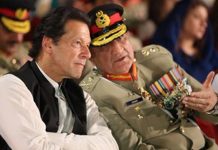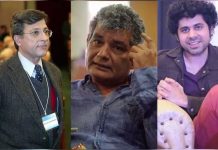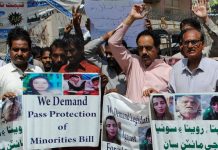There have been three major occasions when the Pakistani middle class has broken away from its traditionally conservative disposition to come out and announce its ‘revolutionary’ political aspirations. The first incident of demonstrating political assertiveness was in the late 1960s when the bulk of the youth began to air their grievances against Pakistan’s military-industrialist nexus headed by military dictator, Field Martial Ayub Khan.
Owing to its inherent conservative worldview, one expected this middle class to oppose a secular-capitalist military dictatorship by siding with the mainstream anti-Ayub religious parties, but the many young men and women who led the revolt against Ayub turned sharply leftwards. They seemed to have embraced ideas such as socialism and social democracy, largely expressed through political organisations such as the Pakistan Peoples Party, the National Students Federation and the National Awami Party. The young, middle-class Pakistani’s romance with the leftist ideology lasted till about 1974, until their ideological darling, Prime Minister Z A Bhutto, gradually dumped his hyperbolic leftist stance to play more pragmatic politics.
This was when middle-class leftist groups on campuses began to succumb to infighting and disillusionment. The vacuum was gladly filled by the electoral rise of petit-bourgeois student parties, such as the Islami Jamiat-i-Tuleba (IJT).
The IJT’s rise on campuses was symptomatic of the anti-Bhutto and anti-left murmurings that had started to gather steam within the country’s urban middle classes, especially in the face of Bhutto’s half-baked socialist policies and increasingly autocratic behaviour. By 1976, the middle-class youth, which, in the 1960s and early 1970s had resonated with progressive proclamations, set itself to rise once again; but this time it rose in search of an Islamic political and economic order. Thus began the second incident of middle class driven agitation in Pakistan that peaked with the right-wing movement against Bhutto’s non- democratic way of governance. Interestingly, whereas the middle-class youth had attacked military and industrialist instruments during the anti-Ayub movement, the anti-Bhutto agitation was openly patronised and at times even funded by the industrialists. It culminated with a military coup against the Bhutto regime and the arrival of Pakistan’s third military dictator, General Ziaul Haq, who cleverly adopted the movement’s Islamist idiom.
Throughout the 1980s, the middle class remained split in its support for Zia’s rather bizarre political-economic edifice that crudely fused the so-called Islamic policies with a free-flowing version of third- world capitalism, and its opposition to the military rule.
As the progressive and the conservative sections went to war on campuses and in the streets, the middle class emerged as exhausted by the time of Zia’s death in 1988 and the restoration of democracy. Only minimal political activity was witnessed from this class in the 1990s when Benazir Bhutto and Mian Nawaz Sharif unwittingly played in the hands of Zia’s ideological remnants in the intelligence agencies and the big businesses. In Karachi the Urdu-speaking urban bourgeoisie became enamoured of the MQM, and was embroiled in the political turmoil that accompanied the state’s operation against the supposed militant outgrowth of the MQM. It was during this decade also that this class (especially in Punjab) started to slide backwards into its customary conservative disposition when a new generation of the Pakistani bourgeois began responding to social and religious conservatism. This tendency exploded into prominence after the confusion and identity crisis (in the Muslim world, specifically in Pakistan) that followed the tragic 9/11 episode.
Gradually, large numbers of young middle-class men and women became interested in ultra-conservative fringe groups headed by drawing-room preachers and televangelists. As the 2000s wore on under the country’s new military dictator, Pervez Musharraf — who chose to play the cosmetic role of a ‘moderate’ — the state and the media failed to arrest the mutated Islamisation trend. From the rugged mountainous areas along the Pak-Afghan border it started making its way into the drawing rooms in urban Pakistan.
The ballooning electronic media facilitated the born-again variety of a middle-class conservatism by adding another batch of religious talking heads. These figures ideologically and commercially cater well to the bourgeoisie’s zeal and political leanings.
Thus has arrived the third agitation of the middle class. But the interesting thing is that this time round this initiative is largely cut off from the country’s mainstream political parties, and has taken the shape of electronic lobbying (blogs, SMS, emails, etc.). What is even more interesting is that though these cyber and TV lobbies are portraying themselves as an alternative movement, these foyers are mostly riddled with a fusion of convoluted leaps of logic, a knee-jerk attitude and a conservative ideological mindset that was actually constructed by the ‘establishment’ and politico-religious parties of Pakistan decades ago. Consequently, what we have at hand as urban middle-class ‘activists’ are actually figurative sheep (single-filed mobs). Now many have also grown fangs of the retro-reactionary-revolutionary variety.
Unless this section of the middle class decides to work within the mainstream political edifice of Pakistan and participate in the evolving democratic apparatus, instead of being repulsed by it, it will remain an irritant, having only a nuisance value. At best it can become the harbinger of a TV lounge revolution, and nothing beyond.
![]()





